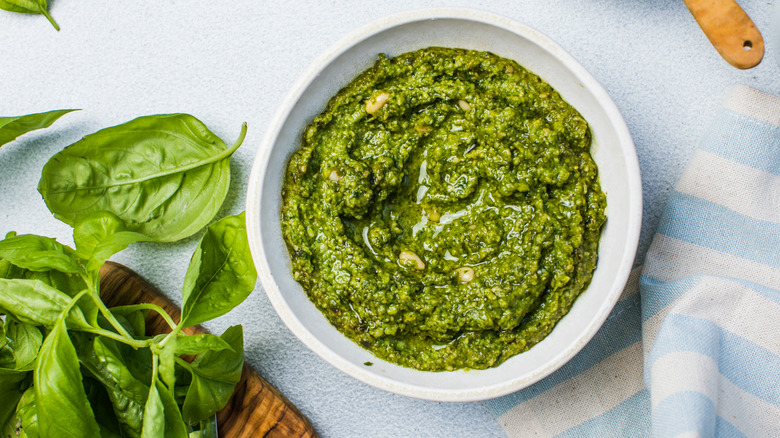Add Feta To Your Pesto For A Salty Bite
By nature, pesto is ripe for variation, depending on the person who's making it and the ingredients at their disposal. We've already shown you ways to make pesto with different herbs, and there are plenty of nuts other than pine nuts that can be used to make a luxurious pesto. There are also many kinds of cheese you can use instead of Parmesan for pesto, including semi-hard Spanish cheeses like Manchego, or an aged Mexican cotija, as they are similar to Parmesan due to their aging and slightly nutty taste. While those would make great substitutions, it's time to think beyond similar cheese profiles and add feta to your pesto for a unique and salty bite.
Feta has many modern variations and options to choose from, but it comes from Greece and was originally made from sheep's milk, or a blend of goat's and sheep's milk, which contribute to its unique tang. Most American-produced fetas use cow's milk, lending them a milder flavor compared to sheep's milk, and can sometimes have a drier texture. Other than Greek-style domestic cheeses, the most commonly available imported fetas are Greek or French. Feta from Greece is sharp with a salty, tangy flavor, while French feta is creamy and mild. If you can, use either true Greek or French fetas for the best flavor to incorporate into pesto, but if domestic is your only option, look for one that's made from sheep's or goat's milk or even a blend of milks, rather than 100% cow's milk.
Feta brings a tangy twist to traditional pesto
Ideally, you should start by purchasing feta that's packaged in its own brine, rather than pre-crumbled, as those can contain anti-caking ingredients that affect both texture and taste, or vacuum-sealed, which can become dry and overly salty. Don't discard that valuable liquid though, as there are plenty of reasons why you should stop throwing out leftover feta brine.
When it comes to the particulars of adding feta to pesto, you can either swap it out for Parmesan entirely or use a smaller amount in conjunction with Parmesan for an extra pop of tanginess and that uniquely briny flavor. Regardless of including the Parmesan or not, it's important not to let the saltiness get away from you in the pesto, which is why we recommend avoiding seasoning with any additional salt until the very end after you've tasted the pesto.
While you could use feta in a traditional pesto with pine nuts, basil, and garlic, there's lots of room to play around with ingredients. Arugula and mint would make an excellent pairing to feta in pesto, as arugula's peppery flavor can contrast feta's saltiness and substitute for raw garlic's sharp bite. Feta would make an especially great swap for Parmesan in this sun-dried tomato pesto pasta recipe. Don't be afraid to play around, and you can start by switching just one ingredient and branching out from there.

